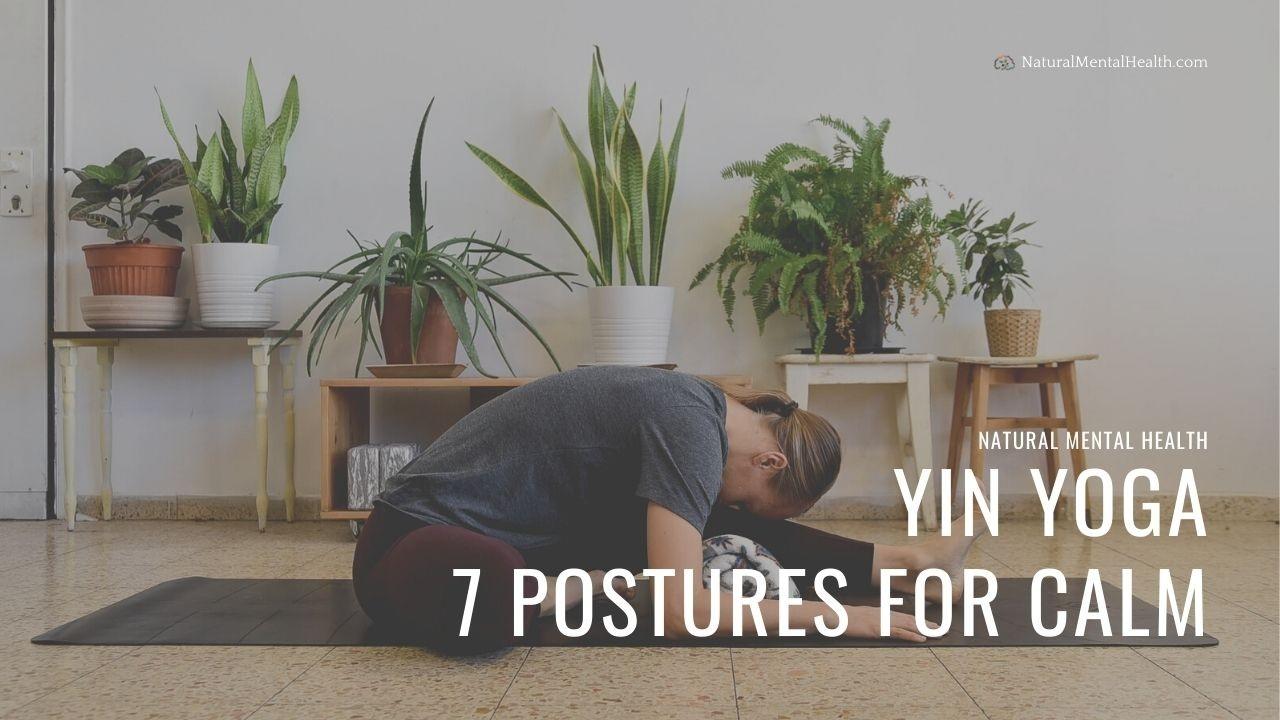
7 Yin Yoga Poses to Support Calm, Joy, and Focus
Dec 18, 2019
by, Elly Hollenhorst
What is Yin Yoga?
Yin Yoga is a form of yoga that is derived from ancient yoga practices dating back thousands of years that was changed and developed in the west starting in the 1970s. In Yin Yoga practice, postures are typically held for 3-5 minutes, though they may be held one minute or longer. Yin Yoga poses work with gravity to passively place gentle stress on the area around the joints and connective tissues to strengthen said tissues surrounding the joints. Yin Yoga is intended to be practiced in conjunction with more active, or yang, practices.
Yin Yoga Benefits
By creating gentle stress the theory is that a routine Yin Yoga practice will strengthen and healthily mobilize fascia and other connective tissues.
Yin Yoga Sequence
Props Needed
- Yoga mat
- 1 Blanket
- 1-2 blocks or pillows (depends on your needs)
- Timer
Instructions
- In yin yoga practice, work towards gentle sensations but never pain.
- Once you are comfortable in each posture, close your eyes and focus on your breath.
- Remain as still and unmoving as possible.
- Let gravity do the work. Do not pull your body into the positions.*
- Rest in each pose for 3-5 minutes resulting in a 30-50 minute practice, depending on how much time you have available. It is helpful to use a timer.
*If a posture feels painful, find another position to better suit your body's needs.
Puppy Pose
Start on all fours with your knees approximately hip width distance apart. Walk your hands forward and rest your forehead on the mat. Allow your chest to melt towards the mat. You may place a blanket underneath your forehead if it is more comfortable. If this posture creates pain or unwanted tension or stress anywhere in your body, particularly in your neck, take extended child's pose by gliding your hips towards your heels and bringing your big toes together to touch.
Hold for 3-5 minutes.

Photo: Adrian Arroyo Solís and Elena Hollenhorst
Supine Spinal Twist
Start by lying on your back. Draw your knees into your chest and roll over to one side. Allow your legs to fall in a comfortable position. Your knees can separate or stay attached/stacked on top of one another. You can place a blanket, block(s) or a pillow underneath your knee if you feel too much stress in your lower back, hips or knees. Place your arms at shoulder height either in T-shape or a goal post position, Your head may look up at the ceiling or over to one side.
Hold for 3-5 minutes. Repeat on both sides.

Photo: Adrian Arroyo Solís and Elena Hollenhorst
Butterfly
Start seated on the floor. Bend your knees and bring the souls of your feet together to touch. If you feel stress on your knees place blocks, folded blankets, or pillows underneath each knee for support. Rest your head on the floor, a block, a pillow or blanket. You may extend your arms in front of you or rest them on a pillow or blanket.
Hold for 3-5 minutes.

Single Legged Forward Fold
Extend one leg out in front of you. Bend the other leg and place the soul of your foot at the inner thigh. If you feel stress on your bent knee you may place a block, folded blanket, or pillow underneath it for support. The knee that is extended forward can be place on the floor or propped up with a block, rolled blanket, or pillow. Repeat on both sides.
Hold for 3-5 minutes. Repeat on both sides.

Photo: Adrian Arroyo Solís and Elena Hollenhorst
Dragon
Start on all fours with your hands directly underneath your shoulders. Step one foot forward towards your hands and place your foot flat on the ground. Allow your hips to gently sink towards the mat. You may place a blanket underneath your back knee.
Hold for 3-5 minutes. Repeat on both sides.

Photo: Adrian Arroyo Solís and Elena Hollenhorst
Dragonfly
Start in a seated position. Widen your legs until you feel a gentle sensation in your inner thigh. Fold forward. You may prop up your torso with blocks, blankets, or pillows.
Hold for 3-5 minutes.

Photo: Adrian Arroyo Solís and Elena Hollenhorst
Seated Meditation
Find a comfortable seat and sit tall. Lengthen your spine. Gently use your abdominal muscles to support your spine. You may sit on a pillow, blanket or a block. You may also find it more comfortable to place a block under each knee to avoid any pain or strain in your knees.
Hold for 3-5 minutes.

Photo: Adrian Arroyo Solís and Elena Hollenhorst
Consult with your physician before beginning any exercise program. The information provided is not intended to be a substitute for professional medical advice, diagnosis or treatment. You should understand that there is the possibility of physical injury when participating in any exercise or exercise program. If you engage in this activity or exercise program, you agree that you do so at your own risk, are voluntarily participating in these activities, assume all risk of injury to yourself, and agree to release and discharge Elena Hollenhorst and Natural Mental Health from any and all claims or causes of action, known or unknown, arising out of your participation.
RELATED ARTICLE
Calming Restorative Yoga
Deepen your practice and try this calming restorative yoga sequence. Read more.








